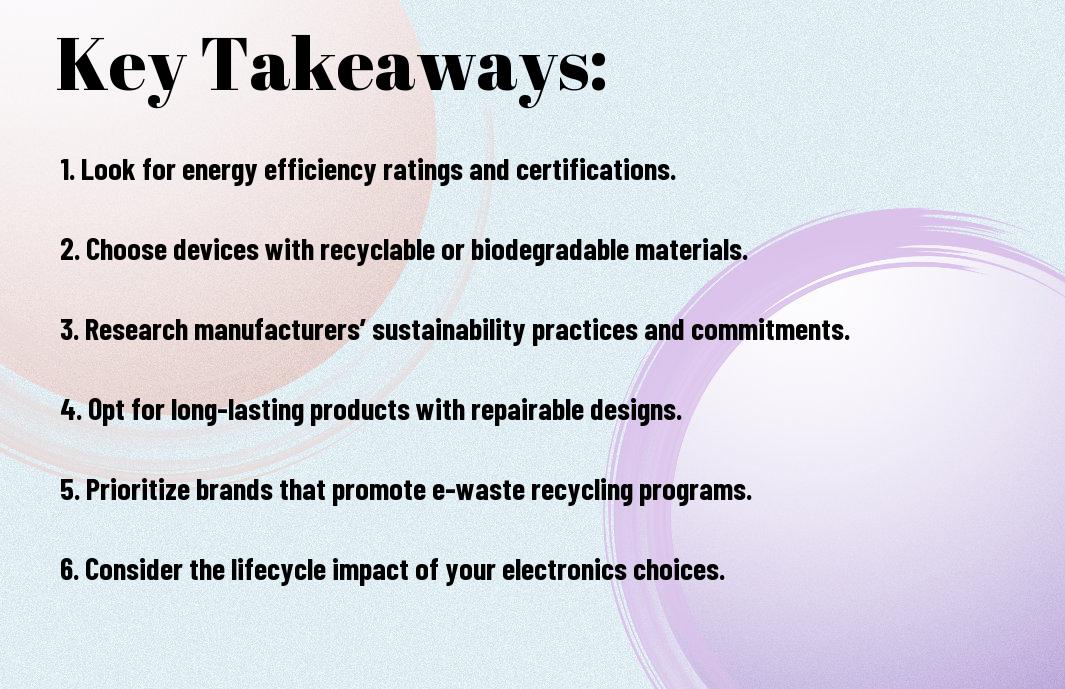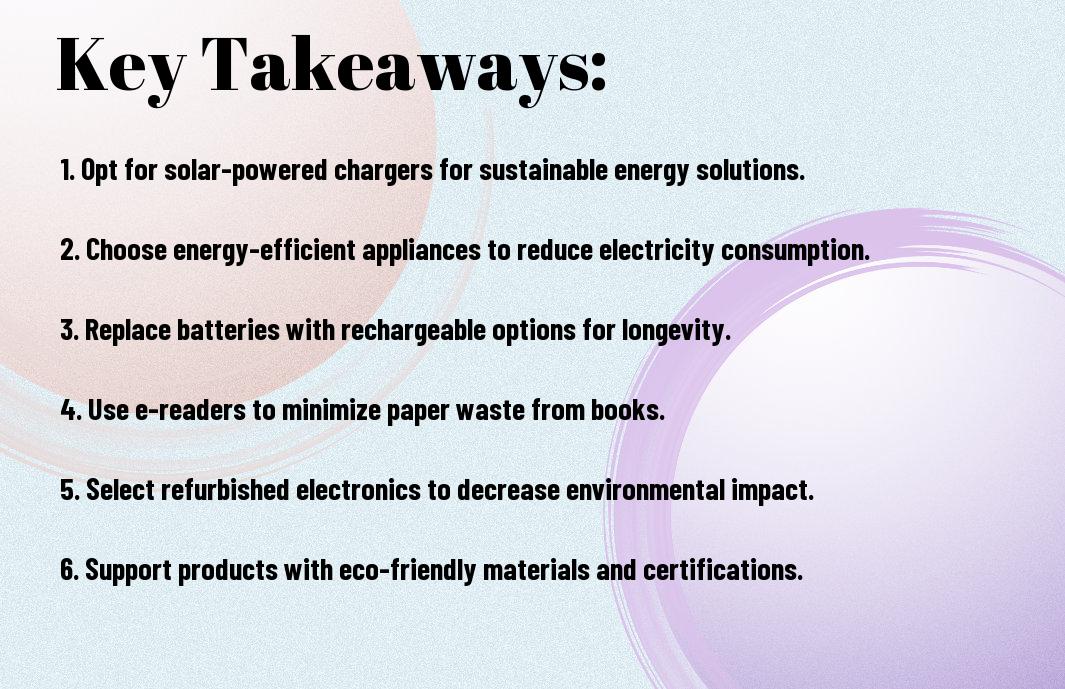As you consider purchasing new electronics, you have the power to make a positive impact on the environment. You can start by educating yourself on the most eco-friendly options available. For guidance, you can check out resources like How to Buy Ethical and Eco-Friendly Electronics (2024), which provides valuable insights into sustainable electronics. By making informed decisions, you can reduce your environmental footprint and contribute to a more sustainable future with your electronic purchases.
Key Takeaways:
To make informed decisions when selecting electronic devices, consider the following points:
- Look for products with energy-efficient designs and features, such as devices with low power consumption or those that use renewable energy sources, to minimize their environmental impact.
- Choose devices made from sustainable materials, such as recycled metals or bioplastics, and opt for products with minimal packaging to reduce waste and support eco-friendly practices.
- Consider the lifespan and upgradability of the device, selecting products with long-lasting components and repairable designs to reduce the need for frequent upgrades and electronic waste.

Defining Sustainability
Before making any decisions, you need to understand what sustainability means in the context of electronics. You will be looking for devices that have a minimal environmental impact and are produced with social responsibility in mind, considering your values and needs.
Environmental Impact
Above all, you should consider the effects of electronic devices on the environment, including energy consumption and waste generation, when evaluating your options.
Social Responsibility
To ensure that your electronics are sustainable, you need to consider the social impact of their production, including labor practices and fair trade, when making your decision.
Due to the complexity of global supply chains, you may need to research the manufacturer’s policies and practices to determine whether they align with your values and priorities, allowing you to make an informed decision that reflects your commitment to sustainability.
Assessing Electronic Devices
Even as you begin to explore your options for sustainable electronics, it’s crucial to evaluate the devices you already own and those you plan to purchase. You’ll want to consider factors such as energy consumption, durability, and the materials used in their construction.
Energy Efficiency
Besides the initial cost, you should look at the energy efficiency of a device, as this will impact your energy bills and carbon footprint over time. You can check the device’s energy rating and compare it to similar models to make an informed decision.
Materials and Manufacturing
Between the device’s design and production, there are various factors to consider, including the source of the materials and the manufacturing process. You should research the manufacturer’s policies on sustainability and e-waste management to ensure your device is made with minimal environmental impact.
In addition to considering the materials used, you should also think about the device’s lifespan and the possibility of repairing or upgrading it, rather than replacing it entirely. You can look for devices with modular designs or those that offer repair services, which can help reduce electronic waste and support a more circular economy.
Evaluating Certifications
After researching the environmental impact of electronics, you’ll likely come across various certifications that claim to promote sustainability. You should understand what these certifications mean and how they can inform your purchasing decisions.
Eco-Labels
Besides the environmental benefits, eco-labels can help you identify products that meet certain sustainability standards. You can look for labels like Energy Star or EPEAT, which indicate that a product has met specific energy efficiency or environmental criteria.
Industry Standards
Along with eco-labels, you should also consider industry standards that promote sustainable practices. You can check if the manufacturer adheres to standards like ISO 14001, which sets guidelines for environmental management systems.
Another aspect of industry standards is the level of transparency and accountability they provide. You can assess whether the manufacturer discloses information about their supply chain, material sourcing, and waste management practices, allowing you to make a more informed decision about your electronics purchase.
Considering the Lifecycle
For a more sustainable approach to electronics, you need to think about the entire lifecycle of your devices, from production to disposal, and consider the environmental impact of your choices.
Production and Packaging
Packaging materials and production processes have a significant effect on the environment, and you can make a difference by choosing products with minimal and recyclable packaging, reducing your ecological footprint.
End-of-Life Disposal
Packaging aside, the way you dispose of your old devices is also important, and you should look for manufacturers that offer take-back programs or recycling options, making it easier for you to responsibly get rid of your unwanted electronics.
At the end of your device’s life, you have the opportunity to minimize its environmental impact, and by choosing a responsible disposal method, you can help conserve natural resources, reduce waste, and decrease the risk of toxic materials ending up in landfills, ultimately contributing to a more sustainable future for your planet.

Researching Manufacturers
Unlike other purchasing decisions, choosing sustainable electronics requires a closer look at the companies behind the products. You will need to investigate their commitment to sustainability, environmental policies, and social responsibility to make an informed decision.
Company Policies
Researching a company’s stance on sustainability is crucial to understanding their values and practices. You can usually find this information on their website, where they outline their policies and goals for reducing their environmental impact.
Supply Chain Transparency
Bridging the gap between a company’s claims and actual practices is key to evaluating their sustainability. You should look for companies that provide clear information about their supply chain, including sourcing of materials and manufacturing processes.
In fact, a transparent supply chain can indicate a company’s commitment to sustainability and accountability. You can check for certifications like Fairtrade or conflict-free, which ensure that the materials used in your electronics are sourced responsibly, and look for companies that publish regular reports on their supply chain practices, allowing you to make a more informed decision about your purchase.
Making Informed Decisions
To make sustainable choices, you need to consider several factors. You will evaluate the environmental impact, energy efficiency, and durability of your electronics, ensuring your choices align with your values.
Balancing Price and Performance
Deciding on the best option requires weighing price and performance. You will assess your needs, comparing features and costs to find the best fit for your budget and requirements.
Personal Values and Priorities
Among the key factors influencing your decision are your personal values and priorities. You will consider what matters most to you, such as reducing waste, conserving energy, or supporting eco-friendly brands.
This approach enables you to make intentional purchasing decisions that not only benefit the environment but also reflect your individual priorities and lifestyle, allowing you to feel confident in your choice of sustainable electronics.
Final Words
Following this guide, you can make informed decisions when choosing sustainable electronics. You will be able to assess your needs and select devices that meet your requirements while minimizing environmental impact. By considering factors such as energy efficiency and recyclability, you can reduce your carbon footprint and contribute to a more sustainable future. Your choices will have a positive effect on the planet, and you will be confident in your ability to make eco-friendly decisions.
FAQ
Q: What are the key factors to consider when choosing sustainable electronics?
A: When choosing sustainable electronics, consider the device’s energy efficiency, material composition, and end-of-life recyclability. Look for products with energy-efficient features, such as LED displays or low-power modes, and opt for devices made from recycled or sustainable materials, like aluminum or bioplastics. Additionally, check if the manufacturer has a take-back program or recycling policy in place to ensure responsible disposal.
Q: How can I evaluate the environmental impact of an electronic device before purchasing?
A: To assess the environmental impact of an electronic device, research the product’s carbon footprint, e-waste generation, and compliance with environmental standards. Check for certifications like Energy Star or EPEAT, which indicate a product’s energy efficiency and environmental sustainability. You can also review the manufacturer’s sustainability report or website to learn about their environmental policies and practices.
Q: What are some sustainable alternatives to traditional electronic devices?
A: Consider alternatives like refurbished or second-hand devices, which can reduce electronic waste and support a circular economy. You can also explore innovative products made from sustainable materials, such as smartphones with biodegradable cases or laptops with bamboo keyboards. Furthermore, some companies offer device-as-a-service models, where you can lease or rent electronics instead of purchasing them outright, reducing waste and promoting sustainable consumption.
Q: How can I ensure that my electronic devices are disposed of responsibly?
A: To ensure responsible disposal of your electronic devices, participate in manufacturer take-back programs or drop off your devices at designated recycling centers. You can also donate working devices to organizations that refurbish and distribute them to those in need. Additionally, consider purchasing devices with modular designs, which allow for easier repair and upgrade, reducing the likelihood of electronic waste.
Q: What role can I play in promoting sustainable electronics and reducing e-waste?
A: As a consumer, you can promote sustainable electronics by making informed purchasing decisions, supporting manufacturers that prioritize sustainability, and advocating for extended producer responsibility. You can also participate in community recycling initiatives, raise awareness about the importance of e-waste management, and encourage others to adopt sustainable electronics practices. By taking these steps, you can contribute to a more circular and sustainable electronics industry.

